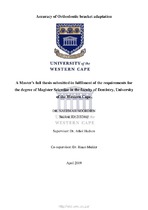| dc.description.abstract | Background: A close marginal adaptation between the tooth and the bracket base is important
since it provides the space for the adhesive. In order to withstand and resist the orthodontic
forces exerted as well as everyday forces like mastication and oral hygiene practices, the
adhesive material to the bracket must have sufficient sheer bond strength. This means that no
deformations, cracks, or fractures should occur within the bracket material and adhesive
(Keizer et al., 1976).
Aim: The aim of this study was to determine the accuracy of the marginal adaptation of the
bracket bases of seven different brands of orthodontic brackets to the tooth surface of a right
upper first premolar (ie. Abzil, Forestadent, GAC, Gemini, IMD, Ormco and Victory LP).
Method: This research was an in vitro, descriptive comparison study. Fifteen caries and crack
free intact human first premolars were used. The teeth were obtained from patients requiring
extractions for orthodontic purposes and collected from Tygerberg Oral Health Centre. A
convenience sample method was used, where whenever an upper caries free premolar was
extracted, the parent was asked if the tooth could be used for this study and consent was
obtained. The crowns of the 15 teeth were cleaned and polished with pumice and rubber cups
for 10 seconds (as the clinician would do prior to bracket cementation). The same 15 teeth were
used with the seven different brands of brackets in order to establish a comparison of the
adaptability of the brackets. The brackets were placed at a set orthodontic prescription of 4mm
(measured from the slot area of the bracket to the tip of the buccal cusp of the tooth) on the
upper first premolars. After bracket placement, the dontrix gauge was applied to the bracket to
engage the slot area. The brackets were held in place with a constant force of 0.70 Newton (N)
by the dontrix gauge. This allowed for reproducibility for the seven brackets with all fifteen
teeth. In order to assess the space between the brackets and the teeth no adhesive was used.
The space between the margins of the bracket and tooth interface was viewed under the
Stereomicroscope (Carl Zeiss microscope, Zeiss Stemi508) at 50 times magnification. A two
way mixed measures ANOVA was run to determine whether there were differences between
the seven brackets placed at six points on the tooth surface.
Results: GAC had the smallest overall mean measurement between bracket base and tooth
surface followed by Ormco and Gemini respectively. Abzil had the largest overall mean
measurement for the six points around the bracket | en_US |

